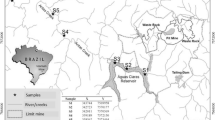Abstract
A sediment sample with high organic matter and trace metal content was suspended in synthetic river water for four weeks under an inert gas atmosphere. Subsequently, the anaerobic suspension was reoxidized by bubbling air through it. The concentrations of dissolved oxygen, sulfide, ferrous iron, manganese, cadmium, cobalt and the pH-value were measured at close time intervals during the anaerobic incubation. The anaerobic suspension was a post-oxic or sub-oxic environment with oxygen and total sulfide concentrations less than 1 µmole 1−1. Concentrations of dissolved ferrous iron and manganese were 50–150 µmole 1−1 and 5–30 µmole 1−1, respectively. The total sulfide concentration was measured using a sensitive voltammetric technique, with a detection limit of 1 nmole 1−1. A sequential extraction procedure was applied to two sediment samples taken at the end of the anaerobic incubation and after one week of reoxidation. The extractions indicated that cadmium was bound in sulfide minerals under post-oxic conditions. Thermodynamic equilibrium calculations revealed that the concentrations of dissolved cobalt in the post-oxic suspension were limited by the precipitation of cobalt sulfide minerals.
Similar content being viewed by others
References
Berner, R. A., 1981. A new geochemical classification of sedimentary environment. J. Sediment. Petrol. 51: 359–365.
Davison, W., 1977. The polarographic measurement of O2, Fe2+, Mn2+ and S2− in hypolimnetic water. Limnol. Oceanogr. 22: 746–752.
Davison, W. & C. D. Gabbutt, 1979. Polarographic methods for measuring uncomplexed sulphide ions in natural waters. J. Electroanal. Chem. 99: 311–320.
Dyrssen, D., 1988. Sulfide complexation in surface seawater. Mar. Chem. 24: 143–13.
Emerson, S., R. Jahnke & D. Heggie, 1984. Sediment-water exchange in shallow water estuarine sediments. J. mar. Res. 42: 709–730.
Evans, R. D., D. Andrews & R. J. Cornett, 1988. Chemical fractionation and bio-availability of cobalt-60 to benthic deposit-feeders. Can. J. Fish. aquat. Sci. 45: 228–236.
Florence, T. M., 1979. Cathodic stripping voltammetry. Part I: Determination of organic sulfur compounds, flavins and porphyrins at the sub-micromolar level. J. Electroanal. Chem. 97: 219–236.
Froelich, P. N., G. P. Klinkhammer, M. L. Bender, N. A. Luedtke, G. R. Heath, D. Cullen, P. Dauphin, D. Hammond, B. Hartman & V. Maynard, 1979. Early diagenesis of organic matter in pelagic sediments of the eastern equatorial Atlantic: Suboxic diagenesis. Geochim. Cosmochim. Acta 43: 1075–1090.
Gobeil, C., N. Silverberg, B. Sundby & D. Cossa, 1987. Cadmium diagenesis in Laurentian Trough sediments. Geochim. Cosmochim. Acta 51: 589–596.
Heggie, D. & T. Lewis, 1984. Cobalt in pore waters of marine sediments. Nature 311: 453–455.
Huerta-Diaz, M. A., 1989. Geochemistry of trace metals associated with sedimentary pyrite from anoxic marine environments. Ph.D. thesis, Texas A&M University.
Jacobs, L. & S. Emerson, 1982. Trace metal solubility in an anoxic fjord. Earth Planet. Sci. Lett. 60: 237–252.
Kersten, M. & U. Förstner, 1986. Chemical fractionation of heavy metals in anoxic estuarine sediments. Wat. Sci. Technol. 18: 121–130.
Kersten, M. & U. Förstner, 1987. Effect of sample pretreatment on the reliability of solid speciation data of heavy metals. — Implications for the study of early diagenetic processes. Mar. Chem. 22: 299–312.
Klinkhammer, G. P., D. T. Heggie & D. W. Graham, 1982. Metal diagenesis in oxic sediments. Earth Planet. Sci. Lett. 49: 81–101.
Kremling, K., 1983. The behavior of Zn, Cd, Cu, Ni, Co, Fe and Mn in anoxic Baltic waters. Mar. Chem. 13: 87–103.
Luther III, G. W. & E. Tsamakis, 1989. Concentration and form of dissolved sulfide in the oxic water column of the ocean. Mar. Chem. 27: 165–177.
Lyons, W. B. & W. F. Fitzgerald, 1983. Trace metals speciation in nearshore anoxic and suboxic pore waters. In C. S. Wong, E. Boyle, K. W. Bruland, J. D. Burton, E. D. Goldberg (eds), Trace Metals in Sea Water. Plenum Press, New York, London: 621–641.
Martell, A. E. & R. M. Smith, 1976. Critical Stability Constants, Vol. 3. Plenum Press, New York, London.
Naumov, G. B., B. N. Ryzenko & I. L. Khodakovsky, 1984. Handbook of thermodynamic data, National Technical Information System, U.S. Department of Commerce.
Orion Research Inc., 1969. Application Bulletin No. 12.
Rapin, F., A. Tessier, P. G. C. Campbell & R. Carignan, 1986. Potential artifacts in the determination of metal partitioning in sediments by a sequential extraction procedure. Envir. Sci. Technol. 20: 836–840.
Sainte Marie, J., A. E. Thoma & A. O. Gubeli, 1964. The stability of thio-complexes and solubility products of metal sulphides. I. Cadmium sulphide. Can. J. Chem. 42: 662–668.
Sawlan, J. J. & J. W. Murray, 1983. Trace metal remobilization in the interstitial waters of red clay and hemipelagic marine sediments. Earth. Planet. Sci. Lett. 64: 213–230.
Shaw, T. J., J. M. Gieskes, R. A. Jahnke, 1990. Early diagenesis in differing depositional environments: The response of transition metals in pore water. Geochim. Cosmochim. Acta 54: 1233–1246.
Smith, R. M. & A. E. Martell, 1976. Critical Stability Constants, Vol. 4. Plenum Press, New York, London.
Smith, R. M. & A. E. Martell, 1982. Critical Stability Constants, Vol. 5. Plenum Press, New York, London.
Smith, R. M. & A. E. Martell, 1989. Critical Stability Constants, Vol. 6. Plenum Press, New York, London.
Stumm, W. & J. J. Morgan, 1981. Aquatic Chemistry. John Wiley & Sons, New York.
Tessier, A., P. G. C. Campbell & M. Bisson, 1979. Sequential extraction procedure for the speciation of particulate trace metals. Analyt. Chem. 51: 844–851.
Wallmann, K., 1990. Die Frühdiagenese und ihr Einfluß auf die Mobilität der Spurenelemente As, Cd, Co, Cu, Ni, Pb und Zn in Sediment- und Schwebstoffsuspensionen. Ph.D. Thesis, Technological University of Hamburg-Harburg, FRG.




